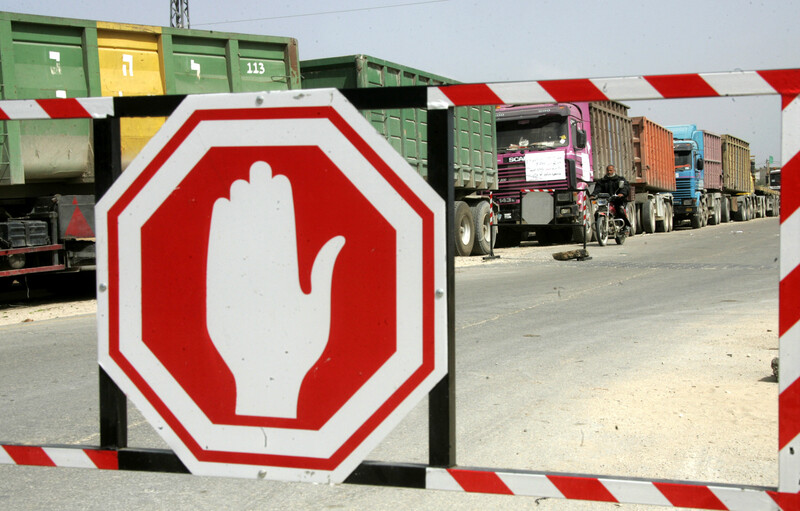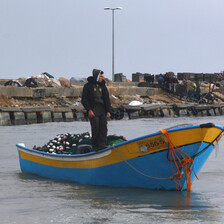The Electronic Intifada Jabaliya 10 September 2012

Israel’s ban on allowing Gaza to export goods has decimated Gaza’s economy.
APA imagesJABALIYA, Gaza (IPS) - “Gaza’s economy is expected to grow modestly and people will likely still be worse off in 2015 compared to the mid-1990s,” read a statement heralding the publication of a United Nations report, “Gaza in 2020 – A Liveable Place?” in August.
In a no-frills office in the Jabaliya refugee camp, Rizik al-Madhoun, 41, explained how his clothing factory began shutting down six years ago.
“We started in 1993 with seven sewing machines. By 2005 we had 250 machines and as many tailors,” he said. “In 2006, after Hamas was elected and Israel sealed the borders, we had to close down half of the factory. We stopped all production in 2007, when Israel tightened the siege.”
Al-Madhoun’s is one of the 97 percent of industrial establishments in the Gaza Strip which by 2008 had stopped production as a result of the Israeli-led closure of Gaza’s borders that limited imports and virtually halted all exports. By December 2007, the UN had already reported that only one percent of Gaza’s 960 garment factories remained open.
Today, a reported 80 percent of factories in Gaza are still closed or operating at minimum capacity.
“Until 2005, our work was good,” said al-Madhoun. “We made shirts, pants, jeans, dresses, skirts, school clothes … we’d make whatever was in demand. Since our clothes were high quality, 80 percent were exported to Israeli markets, and some of these were then exported to European markets.”
His workers were among 40,000 who worked as tailors in Gaza. “Before our factory closed, I employed 250 high-quality tailors, as well as another 100 who worked from home,” he said. “Another 50 families worked from home, doing the final touches and finishing work.”
Devastated
A tour through the vast warehouse that was al-Madhoun’s factory revealed much now unused space, with a few rooms devoted to storing cheap imported clothing. “Now we just have a large storage area. There’s no way we can run our factory, so instead we sell these imports in Gaza markets.”
Focusing on Gaza’s devastated economy, the UN noted in June that “the continued ban on the transfer of goods from Gaza to its traditional markets in the West Bank and Israel, along with the severe restrictions on access to agricultural land and fishing waters, prevents sustainable growth and perpetuates the high levels of unemployment, food insecurity and aid dependency” (“Five years of blockade: the humanitarian situtation in the Gaza Strip”).
Bogus security claims
The Israeli human rights group Gisha has cited estimates that 85 percent of Gaza’s exports traditionally went to Israeli and Palestinian markets outside of Gaza. Gisha has also noted that any claims of security precautions being the reason for prohibiting exports from Gaza held no weight.
“Recently a new scanner for screening goods was installed at the crossing,” Gisha stated in June. According to Gisha, Israeli military officials “have said that the choice to prevent sale of goods from Gaza in Israel and the West Bank was made at the political echelon and needs to be decided upon there” (“Gisha presents: strawberries for sale”).
The Palestinian Centre for Human Rights has reported that the amount of exports allowed to leave Gaza in March were “1.28 percent of pre-closure numbers,” with April exports at “0.85 percent of the pre-closure numbers” (“5 Years and Counting: International Organizations and Donors Continue to Fund Israel’s Illegal Closure on the Gaza Strip”).
Gaza’s unemployment rates continue to hover between 35 and 65 percent and food aid dependency remains at 80 percent.
“An urban area cannot survive without being connected,” UN representative Maxwell Gaylard stated in August, reiterating the necessity to reopen Gaza’s closed borders to trade.
“The area has been essentially isolated since 2005,” read the UN statement, “meaning that, in the longer term, its economy is fundamentally unviable under present circumstances. Gaza is currently kept alive through external funding and the illegal tunnel economy.”
The recent United Nations’ report concluded by insisting that, among other things, the Palestinians of Gaza “must have ready access to the world beyond Gaza for religious, educational, medical, cultural, commercial and other purposes.”
Rizik Al-Madhoun simplified the call: allow Gaza’s exports out.
“Since we have so few options for work, Gaza’s tailors have perfected their crafts,” al-Madhoun said. “We can make clothes as good and better quality than the Turkish imports we get, but without a market, there is no point in producing goods.”
All rights reserved, IPS - Inter Press Service (2012). Total or partial publication, retransmission or sale forbidden.





